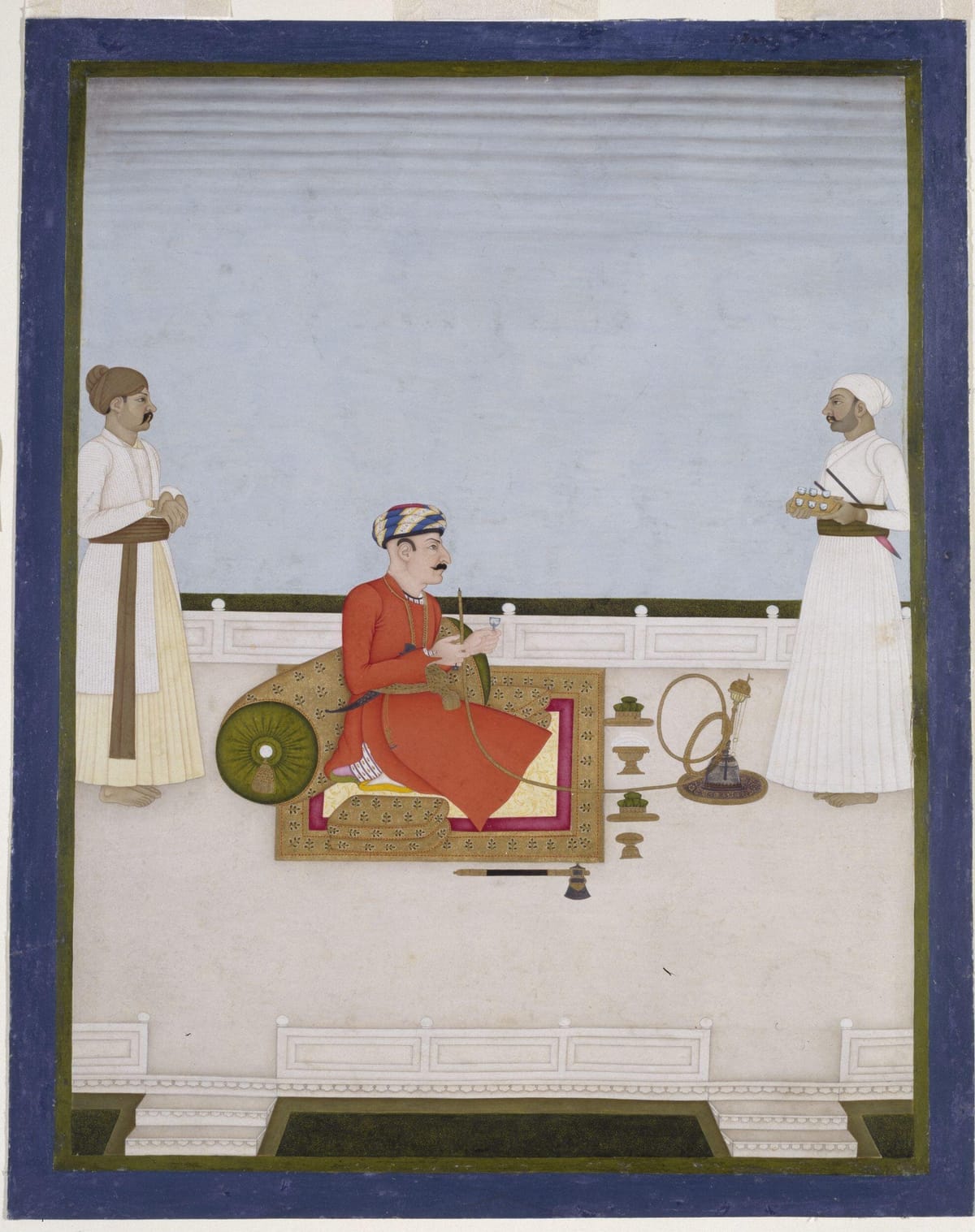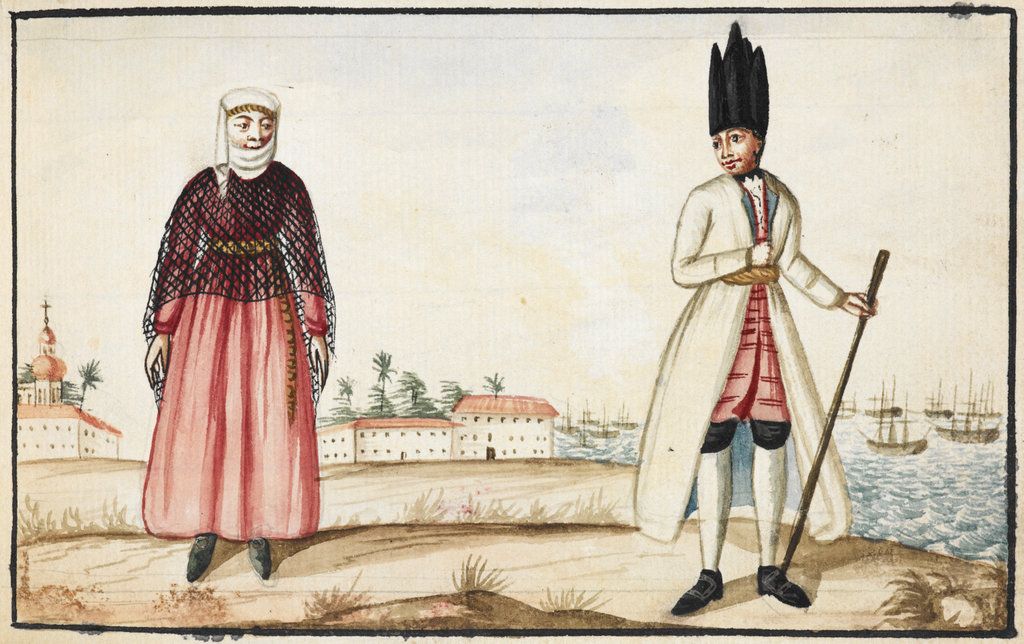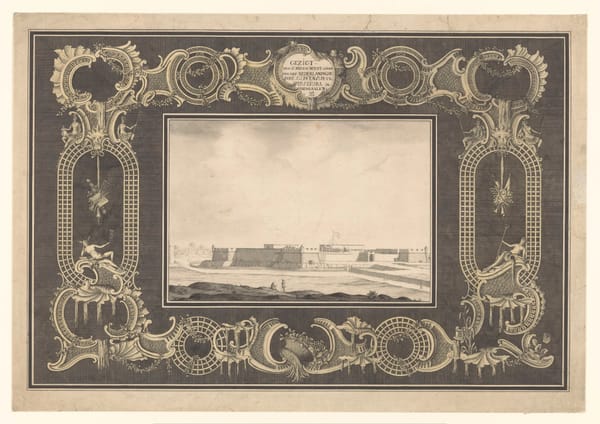Armenian Portfolio Capitalists and the Advent of East India Company Rule in Bengal

In the 1760s an Armenian resident in India, Tovmas Khojamalian, completed a sweeping history of India. One of the latter chapters of his work concerned, as the chapter subtitle had it, "The manner in which the English conquered India [and] how the Armenians rose to power and lost it" (From the Russian translation by Abramian, Armianskie istochniki XVIII, Figure 1). As Khojamalian chronicled at length, several Armenians were military officers in the army of the nawab of Bengal, Mir Qasim. Among the most famous of these Armenians was Gurgin Khan (pictured in the feature image above). Gurgin Khan, formerly known as Khoja Grigor (Coja Gregore in English documentation), was the brother of two prominent Armenian merchants, Khoja Petrus (Coja Petrus) and Khoja Arathon (Coja Aratoon).
Natives of New Julfa, a suburb of Isfahan in Iran, these brothers traveled to India sometime in the 1740s and quickly acquired prominent military, political, and economic positions in Bengal. They are all said to have participated in the Plassey conspiracy. (For more on these events, Coja Petrus and his brothers cf. Mesrovb Jacob Seth, Armenians in India, esp Ch. XVIII.) After the accession of Mir Qasim, Gurgin Khan reformed the nawab's infantry along European lines, and filled his ranks with Armenian commanders like Markar, who later gained notoriety for driving the English into a full-blown retreat from Patna in 1763. (Malleson, Lord Clive, Vol. 7, 153-6; Bhattacharya, “Gurgin Khan,” 148.)
Combing interests in trade, military affairs, and politics, these Armenians were representative of a wider group of actors in eighteenth-century India whom C.A. Bayly and Sanjay Subrahmanyam once identified as the “portfolio capitalist.” In a classic piece from 1988, Bayly and Subrahmanyam coined the term to identify a cast of “intermediate” entrepreneurs who became stakeholders in agrarian revenue systems, external trade, and the military labor market in early modern South Asia (Bayly and Subrahmanyam, "Portfolio capitalists"). One aspect of Bayly and Subrahmanyam's argument bears particular relevance here: where historians of South Asia before them tended to argue that merchants were apolitical creatures and that the divide between the political and the mercantile realms was insuperable, Bayly and Subrahmanyam maintained that merchants were actively involved in kingmaking. Any purported gap between the political and mercantile was in fact permeable, transgressed by portfolio capitalists who flouted the neat categories of later historians.

In mid-eighteenth century Bengal a salient feature of portfolio capitalism was the clash between the East India Company (EIC) and rival portfolio capitalists. The many Armenians in the service of the Nawab of Bengal were chief among these. But even those Armenians who remained aloof from political affairs and stuck strictly to trade became engaged in a series of contentious legislative battles with the EIC, which was eager to defang competing merchant networks. Habituated to a world of legal pluralities, and jealous of the corporate privileges that were hitherto the norm for the Armenian diaspora in Eurasia, many Armenian entrepreneurs in Bengal found themselves at odds with an expanding company-state.
Ever since the conclusion of a trade agreement between the EIC and the Armenians in 1688, substantial numbers of New Julfan Armenians had migrated to India, where they bolstered the long-established Armenian communities of Calcutta, Chinsura, and Saidabad in Bengal. They also had a presence in Goa, Madras, Chandernagore, Hyderabad, and Bombay. The EIC had made strong efforts to attract Julfan Armenians to its settlements in this period and the original 1688 agreement granted Armenians a number of special privileges, including freedom of worship, liberty of movement, low taxes, and access to Company ships. The bait was all-the-more enticing because Company settlements like Madras were not only important regional commercial centers, but often had a printing press and Armenian churches.

Armenians in India in the second half of the eighteenth century were by no means consistently supplicant clients of the EIC. After all, Armenian entrepreneurs did not shy away from contesting the EIC's arbitrary seizure of their goods in the Admiralty's Court (Aslanian, “Trade Diaspora versus Colonial State"). But a broader showdown with the EIC occurred in this period in large measure because of sustained Armenian relationships with local Indian rulers. Particularly after the Battle of Plassey in 1756, the situation in Bengal was radically altered by the EIC's acquisition of hegemony in the province. Henceforth, the Company refused to pay lip service to the nawab and actively sought to curtail his powers and restrain his influence. Caught in between were many Armenians either employed directly by the nawab or living in his domains.
Jealous of its sovereignty, the Company was unequivocal from the mid-1750s that Armenians in Bengal lived "under the Company's protection” (A letter to the proprietors of East-India stock, from Henry Vansittart: occasioned by a late annonymous pamphlet, and by the East India Observer, Issue 6 (London, 1767), 142). If the Armenians were permitted to remain in Bengal only at the EIC's sufferance, then it was expected that they would abide, like obedient boarders, to the Company's rules. Unsurprisingly, many Armenians attempted to dabble in political intrigue against both the nawab and the British, but increasingly they were forced to choose sides as the struggle over Bengal's political future became a zero-sum game.
Many Armenians became parties to the schemes of the EIC, often as military retainers, such as during the siege of Fort William in 1756. By one count, there were 285 Armenians, Indian Portuguese, and other natives among the town's militia forces (Gupta, Sirajuddaullah and the East India Company, 61.) This did not mean that Armenians as a whole were content to usher in the supremacy of the EIC. As an example, during the siege of Madras by the French in 1758, an Armenian merchant sent the French general, Thomas Arthur, Comte de Lally, 24,000 livres; this at a time when the French war chest had fallen to 4,000 livres. (Memoirs of Count Lally … (London, 1766), 15-6.)
In like measure, many Armenians participated in the 'revolution' that accompanied the Battle of Plassey in 1757. Around the time of Plassey, one Armenian, Coja Wajeed, proved especially flexible in his loyalties. On the one hand, he connived to bring a Dutch force from Batavia to Bengal in the hopes of arresting the growth of English power, while actively dealing with EIC and even corresponding with Robert Clive to whom Wajeed proclaimed his special regard for the EIC. (Henry Vansittart, A Narrative of the Transactions in Bengal, from the Year 1760, to the Year 1764: During the Government of Mr. Henry Vansittart, Vol. 1 (London, 1766), 50; Chatterjee, Merchants, Politics, and Society, 102-7; “Extract from a letter from Coja Wajid to Colonel Clive, dated 17 January, 1757,” in Hill ed. Bengal in 1756-1757, 110).
Clive remained distrustful of the Armenian, unable to shake off the conviction he was a French agent (Chaudhury, The prelude to empire: Plassey revolution of 1757 (Manohar, 2000), 138-9; Chaudhury, “Armenians in Bengal Trade and Politics,” 152; Bhattacharya, “Armenian-European Relationship,” 314.) Wajeed proved a special nuisance to the EIC for, throughout the 1750s, he also maintained a monopoly on the saltpetre trade that several European companies had unsuccessfully tried to circumvent. After Plassey, the Company, in its newfound position of hegemony, wrested it from the Armenian and established a monopoly of their own the trade (Chaudhury, “Armenians in Bengal Trade and Politics in the Eighteenth Century,” 152).
The period after the Plassey conspiracy witnessed the most heated clashes between the EIC and the Armenians. Another dramatic episode featured a certain Coja Haddi, assassinated by the nawab in November 1758 for his attachments to the English. A general in the nawab's army, Haddi had been commander of some 16,000 soldiers ordered to attack Colonel Clive at Patna. But the nawab's real intention was to rid himself of Haddi, and accordingly sent word to Clive informing him of his machinations. Clive proved uncooperative, notifying Haddi of the plan. The Armenian then let the Company's army march through the city and encamp on the opposite side, an action which instigated a welter of conspiracies that led to the Coja's assassination. (Luke Scrafton, Reflections on the Government of Indostan: With a Short Sketch of the History of Bengal, from MDCCXXXVIIII to MDCCLVI; and an Account of the English Affairs to MDCCLVIII (1764), 104-5).
Into the 1760s what big-time Armenian merchants remained in Bengal were regarded as antagonists of the Company. A contemporary letter written at Fort William by the Council of the EIC not only accused Armenians at the nawab's court of actively working against the English, but asserted that “through the means of these men, the Armenians in general are setting up an independent footing in the country, are carrying on a trade greatly detrimental to our investments in all parts, and commit daily acts of violence, which reflect no small odium on the English...” ( Seth, Armenians in India, 339-40). This missive was part of a larger pattern. In 1763, a Company official condemned the nawab's remitting of duties on trade over the previous two years and his patent disregard for the EIC's trading privileges, blaming Armenians for pushing the nawab to pursue this course of action, all with the aim of protecting their own beleaguered trading interests. (“Mr. Hay's Opinion,” in A Narrative of the Transactions in Bengal, from the Year 1760, to the Year 1764: During the Government of Mr. Henry Vansittart, Vol. 3 (London, 1766), 65). Two violations particularly angered the English – the Armenian disregard for the dustuck (Hindi – dastak - passport or customs permit) and purwannah (parwāna – written pass or certificate) granted exclusively to the EIC.
The showdown over these violations came to a head in 1761 when a certain Coja Antoon, an agent of Coja Gregore and the Nawab's collector of rents in Punchmahla, was arrested for purchasing five maunds of salt-petre and sent to the Company factory at Patna. The purchase of salt-petre was, by a parwāna of the nawab, limited exclusively to the Company. Consequently Antoon's purchase was regarded as “an infringement of the English rights, equivalent to a robbery, and was termed such.” Appeals to Company officials by the Naib of Patna, Raja Rajebullub, did not lead to a lessening of the sentence, and Antoon was dispatched to Calcutta in chains. Antoon's activities were perceived by Company factors as “proof of the Nabob's disregard of our privileges, and the insolence of Armenian authority.” (A Narrative Of The Transactions In Bengal, From The Year 1760 to the Year 1764, During the Government of Mr. Henry Vansittart (London, 1766), 304.)
Infuriated by what he perceived as a gross breach of his sovereignty, the nawab wrote to Company officials:
“If that person [Antoon] had committed any fault, it would have been proper to have informed me of it, since my interests and the Company's are united. It ill became you to seize an officer of my government, who was intrusted with affairs of great consequence...Since my servants are subjected to such insults, my writing can be of no use...How much my government and authority are weakened by these preceedings I cannot describe.” (Henry Vansittart, A Narrative Of The Transactions In Bengal, Vol. I (London, 1766), 305-306).
Following extensive deliberations and an interrogation of the accused, the Company's Board in Calcutta concluded that Antoon must be made an example of, though they added “but as he is a servant of the government's, it properly belonging to the Nabob to chastise him.” (Extract of a Consultation, held at Calcutta the 11th of February, 1762 (Present Mes. Vansittart, Amyatt, Johnstone and Hay), 325.) Though they agreed to hand Antoon over to the nawab, the Board demanded in a letter to the nawab that Antoon be punished in full public view so as to prevent others from “carrying the petre out of the country, and calling our dustucks in question" (Ibid., 325-326).
Just as they fueled tensions between the EIC and the nawab, Armenians also caused considerable rancor within the ranks of the EIC itself. Because many Armenians acted as agents for the EIC, they also functioned as facilitators for Company personnel to engage in the mixture of malfeasance, private trade, and looting common to the corporation's Bengal kleptocracy. Yet the Armenian agents also supplied an opportunity for Company officers to pursue vendettas against one another. The most famous illustration of this was the court case that a group of Armenian merchants - Coja Gregore Cojamaul, Coja Johannes Padre Rafael, Coja Melcomb Philip, and Coja Wuscan Estephan - brought against Harry Verelst (the governor of the Bengal) and the Company in London in 1769. The cases have already been expertly dissected by Willem G.J. Kuiters (Kuiters, The British in Bengal, esp. 237-60; Kuiters, "Armenians contra Verelst") A stalwart champion of the Armenians was Willem Bolts. Bolts was an (in)famous Dutch servant of the EIC who later wrote a blistering polemic against the Company's administration in India (Bolts, Considerations on India Affairs). Before his passage out of Company employment, he had become embroiled around 1765 in a series of disputes involving Armenian agents and EIC officials in Bengal.
Now from London, Bolts took up the cause of the Armenians. He wrote directly to the President and Council of Calcutta, on behalf of Rafael, Philip, and Cojamaul, whom he called his agents, recounting at length the injustices visited upon the merchants and emphasized that the recent legislation passed prohibiting Armenians from trading in Company territories would surely lead to their financial ruin. He further argued that Verelst had acted illegally and presented as evidence the legitimate Company parwānas possessed by the merchants at the time they were apprehended. (“Num. LXXXIV. Copy of a Letter from William Bolts to the President and Council of Calcutta, on the Imprisonment of his Agents, and the President's disgracing the Rajah Bulwantsing's Ambassador, and turning him out of Calcutta, on a mere Supposition of his having furnished W. Bolts with Intelligence. Dated the 27th July 1768,” in Appendix E., 413-6; Kuiters, The British in Bengal, 238-41). The subsequent trial proved to be acrimonious and protracted. After a re-trial, the jury eventually ruled in favor of the Armenians on all counts. Verelst was forced to pay exorbitant damages, for which he was later compensated by the Company's Court of Directors (Kuiters, The British in Bengal, 252-3).
Despite the Armenians' victory in London, the crystallization of outright EIC rule in Bengal by the 1770s meant the elimination of the fluidity of political relationships between indigenous merchants and political power hitherto characteristic of eighteenth-century Bengal. In this climate, it was no longer possible for groups like the Armenians to maintain their positions as portfolio capitalists combining economic capital with a hand in kingmaking. Henceforth, the Armenians and other Indian mercantile groups were subordinate players in the dramatically altered political economy of the early colonial period in India.
Secondary Sources
R.A. Abramian, Armianskie istochniki XVIII v. ob Indii (Erevan, 1968).
Sebouh Aslanian, “Trade Diaspora versus Colonial State: Armenian Merchants, the English East India Company, and the High Court of Admiralty in London, 1748-1752,” Diaspora: A Journal of Transnational Studies, Volume 13, Number 1, Spring 2004, 37-100.
C.A. Bayly and Sanjay Subrahmanyam, "Portfolio capitalists and the political economy of early modern India," The Indian Economic & Social History Review, 25:4 (1988), 401–424.
Bhaswati Bhattacharya, “Between fact and fictions: Khoja Gregory alias Gurgin Khan, the “Evil Genius” of Mir Qasim.” Jos Gommans & Om Prakash eds., Circumambulations in South Asian history: essays in honour of Dirk H.A. Kolff, (Leiden, 2003), 133-158.
Kumkum Chatterjee, Merchants, Politics, and Society in Early Modern India: Bihar, 1733-1820 (Leiden, 1996).
Sushil Chaudhury, The prelude to empire: Plassey revolution of 1757 (New Delhi, 2000).
Sushil Chaudhury, "Armenians in Bengal Trade and Politics in the Eighteenth Century," Sushil Chaudhury and Keram Kevonian eds., Armenians in Asian Trade in the Early Modern Era (Paris, 2007), 149-170.
Brijen Kishore Gupta, Sirajuddaullah and the East India Company, 1756-1757: Background to the Foundation of British Power in India (Brill, 1962).
S.C. Hill ed. Bengal in 1756-1757: A Selection of Public and Private Papers Dealing with the Affairs of the British in Bengal During the Reign of Siraj uddaula, vol. II (London, 1905).
Willem G. J. Kuiters, “Law and Empire: The Armenians Contra Verelst, 1769-1777,” The Journal of Imperial and Commonwealth History, 28: 2 (2000): 1-22.
Willem G.J. Kuiters, The British in Bengal, 1756–1773: A Society in Transition seen through the Biography of a Rebel: William Bolts (1739–1808) (Paris, 2002).
George Bruce Malleson, Lord Clive and the Establishment of the English in India, Vol. 7 (Oxford, 1907).
Mesrovb Jacob Seth, Armenians in India, from the Earliest Times to the Present Day: A Work of Original Research (Calcutta, 1937).





